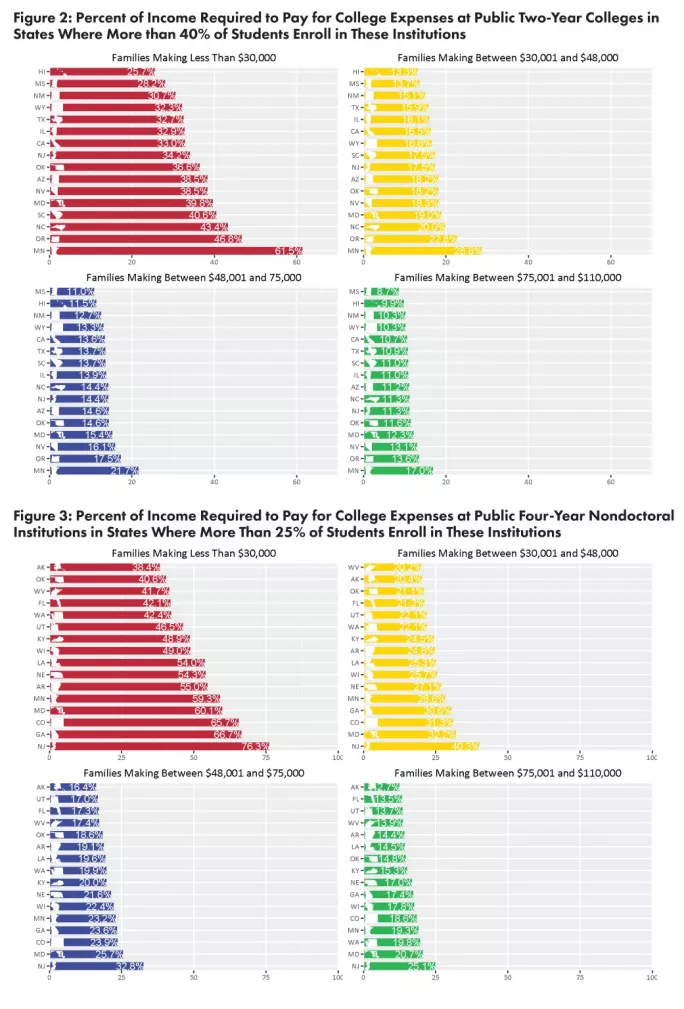- Home
- Affordable colleges are quickly disappearing
Affordable colleges are quickly disappearing

The converging trends of falling state investment, rising tuition and stagnant incomes have finally pushed higher education out of the grasp of low- and middle-income Americans, even at community colleges, a new report contends.
“If you’re making $10,000 to $30,000 a year, and you need 10 percent to 15 percent of family income to attend community college, it’s just not going to happen,” said Joni Finney, director of the Institute for Research on Higher Education at the University of Pennsylvania and co-author of the study.
The cost of living in general and of college in particular has increased for many low- and middle-income families while wages have largely stagnated over the past few decades, and per-student state investment in public education continues to lag pre-recession levels, the report states.
Leveling the playing field
Even at community colleges, most full-time, low-income students would need to work more than 20 hours a week to afford their educations-which workload experts say makes it all but impossible for them to successfully complete a degree.
The result is that far fewer low- and middle-income students will enroll in college at a time when the country has set a goal of producing more degree-holders to stay competitive with international economic rivals.
While policy leaders “talk passionately about wanting to level the playing field,” their funding commitments haven’t aligned with the goal of helping needy students, the study says. “Unless we make college affordable for people of all financial means, opportunity through higher education will be a false promise.”
Unlike other attempts to analyze college affordability, the report-a joint effort of the Higher Education Policy Institute, Vanderbilt University and the University of Pennsylvania-examines tuition and cost-of-living expenses, and compares those to the typical state and federal aid given to students who aren’t well off.

Between 2008 and 2013, the last period for which the information is available, 15 states lowered the full-time cost of attending community college. Four-year public universities became more affordable in six states.
Affordability across all types of colleges and universities declined in 45 states.
Families of students at four-year public universities and colleges in high-population states including Illinois, New Jersey and Pennsylvania now pay the equivalent of 35 percent or more of their annual incomes to afford school. In Massachusetts and Virginia, the family of a typical student is charged the equivalent of 32 percent of its annual income.
Attending community colleges in many states accounts for around a fifth of students’ family incomes, on average.
Typical college expenses in 12 states are low enough so that community-college students could afford the cost of attendance by working 20 hours or less: Alabama, Arkansas, Connecticut, Georgia, Hawaii, Illinois, Kentucky, Michigan, Mississippi, Utah, Virginia and West Virginia.
“Where you grow up can determine your opportunities for higher education,” the authors write. “College costs, available aid, and institutional options vary dramatically by state, sometimes within the same region.”
Low-income and middle-class families are feeling the financial squeeze even before contending with tuition.
Federal data show that annual expenses already exceed annual incomes of families earning less than $50,000. Even households earning between $50,000 and $69,000 spend an average of 87 percent of their wages on typical purchases, making it hard to save for college.
“This has been happening slowly, over time, since the early 1990s,” Finney said in an interview. “When the state abdicates responsibility for public policies related to affordability, it disproportionately hurts low- and middle-income families.”
How to fix this is another question, particularly as universities warn of even deeper financial problems.
“Absent any kind of state and federal policy interventions, these trends will only escalate,” Finney said.
And while some states, such as Tennessee and California, have worked to keep tuition low-especially for community college students-tuition consumes only a third of what students have to pay. Fees, books, supplies, food, and housing add substantially to that.
Meanwhile, higher-income families have come to enjoy increased proportions of states’ financial aid.
While the amount of need-based state financial aid for students at four-year public universities and colleges has barely budged between 1996 and 2012, state financial aid for high-income students at those institutions jumped 450 percent, the report says.
Mikhail Zinshteyn is a writer and program manager at the Education Writers Association. He tweets as @mzinshteyn.
This story was produced by The Hechinger Report, a nonprofit, independent news organization focused on inequality and innovation in education.
Want to keep up with the latest education news and opinion? Follow TES USA on Twitter and like TES USA on Facebook
Keep reading for just £1 per month
You've reached your limit of free articles this month. Subscribe for £1 per month for three months and get:
- Unlimited access to all Tes magazine content
- Exclusive subscriber-only stories
- Award-winning email newsletters